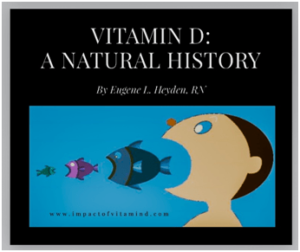Fibromyalgia Story

Last update: 03-17-2025
By Eugene L. Heyden, RN
A decade or so ago, I developed quite an interest in fibromyalgia, what it is, and what can be done. After years of study, here is my conclusion: Fibromyalgia is whatever occurs that negatively affects muscles and nerves, producing chronic, widespread pain that persists. Well, that was quite vague. I’ll go into greater detail.
For a particular individual, fibromyalgia could be a collection of symptoms arising from hypothyroidism, undetected or improperly managed. Hypothyroidism negatively affects just about everything, including skeletal muscle.
Fibromyalgia could be, as we have previously discussed, symptoms of prolonged vitamin D deficiency. And fibromyalgia could arise from any number of hormonal imbalances, particularly those related to the stress hormone cortisol. Undoubtedly, fibromyalgia could stem from a failure to adequately repair the everyday damage that occurs to muscles, damage that should be repaired at night, when one should be receiving adequate, restorative sleep. For many of us, restorative sleep is nowhere to be found.
And this is my pet theory: Fibromyalgia could be a manifestation of insulin resistance, a sorry state of affairs that screws up just about everything.
Finally, fibromyalgia could be a subtle dysregulated inflammatory response to something yet to be identified, perhaps a bacterium or a virus, and muscles pay the price.
Fibromyalgia is often associated with depression, sleeplessness, and more sleeplessness and more depression. (And did I mention more muscle pain?) Fibromyalgia may not be one single thing; it may be several things that are all rolled up into a ball and given a fancy name.
Since fibromyalgia is considered a “modern” disease, let’s see if we can give a modern person, like Betty over there, symptoms that we can later label as fibromyalgia. This should be fun! Let’s get started without delay.
Of course, we will want to make Betty vitamin D deficient. That’s a must! Over time, this is certain to harm muscle. And it should be fairly easy to accomplish. Fortunately for us, Betty’s faithful use of sunscreen has given us a good head start. Faithful sunscreen use is the gift of vitamin D deficiency.
Since Betty is a young adult and not made out of money (and neither is her husband), she will need to hold down a job. So, we now find her working at the local toothbrush factory. Toothbrushes are heavy, and the work is notoriously demanding, so she can only work part-time, say, at most, 3 days a week. On the other days of the week, surrounded by all her labor-saving devices, she will make it through the day, resting and watching daytime TV. Historically, Betty has never hung clothes out on a clothesline, not once in her entire life, although she thinks she has seen one on the History Channel. The Price Is Right and Days of Our Lives have become very important to her, more important than going outdoors and getting a little sunshine during the time of day when she could easily make 20,000 IUs of vitamin D per session and be better protected from disease. But I did notice that she received a paltry 400 IUs of vitamin D in her multivitamin supplement this morning, so she is sure to squeak by, and we may have to wait a little longer to see if the symptoms of fibromyalgia will show up in force. But we don’t have all day. Perhaps we can speed things along.
Hey, I have an idea! Let’s give Betty financial worries and, just for fun, add the stress of pregnancy. Financial stress is certain to keep her up late at night worrying and losing sleep. Pregnancy, too, can be very stressful—continuously expanding in size while being kicked at all hours by what feels like three pairs of legs. And what a coincidence. According to the ultrasound, Betty is expecting triplets!
The pregnancy, with all the expanding and all the kicking, will rob Betty of good quality sleep, restorative sleep—and do so night after night after night. Skeletal muscles do not handle sleep loss very well. We know this because muscle pain can be induced relatively quickly, even in healthy test subjects, simply by disrupting their sleep patterns. With triplets, Betty is bound to face even more sleep deprivation in the future. Triplets always need something to eat—or rather, drink—on demand, day and night. For Betty, losing sleep will continue to be an inescapable part of life. But I’m getting ahead of my story; the triplets have not yet been born. That will soon change. After a brief 23-hour labor, they finally arrived (on the outside).
Because Betty has been made vitamin D deficient, her breast milk will also be vitamin D deficient, with precious little available to pass on. Therefore, the triplets will be sick quite often, and “Mom” will lose even more sleep and feel like pulling her hair out from all the stress. (Are you able to relate to any of this?) Betty, the Mom, will undoubtedly be far too tired and busy to get outdoors during the time of day when she could directly convert sunlight into vitamin D. Goodie for us. Bad for Betty.
Now the bills are piling up, so it’s back to the toothbrush factory after a brief and insufficient maternity leave. Betty hardly ever sees her husband anymore (he is busy trying his best to get ahead in life), so we will not mention him further. But if we run into him again by chance, Betty has asked us to scold him for not helping more around the house and helping more with the triplets, one of whom, the runt, seems to be having motor and neurodevelopmental difficulties. The doctors are stumped.
Can you see that we are deliberately setting Betty up for something bad to happen? Our hope, and according to our diabolical scheme, is that the outcome will be fibromyalgia. But Betty seems more resistant than expected, and we’re running low on time. So, let’s throw a few more challenges her way. First, however, let’s see where things stand.
In review and according to plan, we are ensuring that Betty will be low in vitamin D and remain so for an extended period. We are robbing her of restorative sleep, knowing that this, too, over time, can cause a syndrome of widespread, unrelenting pain. We’ve arranged things so that the only life she has, apart from work, is more work at home, indoors. And for good measure, we’ve added quite a bit of stress to her life. But Betty has an outlet (or two), offering her a little diversion from the burdens of the day. It is called late-night TV.
Late-night TV has become a central feature in the little life that Betty has left (to herself). And while she watches, she snacks. And while snaking, she gets her snuggling in. Who can blame Betty for this? After all, she does deserve some quality time for herself and quality time with her husband. Okay, we’ve written him back into the story because, luckily for us (and for him), his plans include further sleep loss for Betty. Soon after a brief period of stress relief, Betty’s husband will begin snoring (like a freight train), keeping Betty awake even longer and removing her from anything that resembles a good night’s sleep. And poor Betty, because of her snacking on potato chips and the like, she is packing on the weight, particularly around the middle. Of course, she starts worrying about her weight and how she will fit into the bathing suit she will never wear. All of this is according to plan. Fibromyalgia, here we come!
You and I are little stinkers. In addition to all we have done to Betty thus far, we have also started her down the path of living the insulin-resistant life. All the snacking (on simple carbohydrates and omega-6 fatty acids) will come in handy as we inch closer to our goal. However, now that the triplets have grown up and left home, our plan may be in jeopardy. Now, Betty may be able to get more sleep and have more time for leisurely outdoor activities. But don’t count on it. Besides being all worn out, Betty is a creature of habit, so it is more late-night TV for her! And she will be losing even more sleep worrying over the triplets, the bills, and the possibility that the toothbrush factory will close and her job will be shipped overseas.
For the record, we had nothing to do with the following—at least, I don’t think we did. Betty’s hormones are starting to get out of whack, and things are bound to escalate! She is likely to become depressed any day now (if she isn’t already). As a result, frequent visits to her doctor are inevitable as she seeks relief from a growing list of health problems.
Fortunately for us, the doctor seems to overlook the importance of vitamin D, preferring to address symptoms with medication rather than digging deeper to find an underlying cause. While Betty might experience some temporary relief—medications can help, but likely not for the long haul. Her chronic vitamin D deficiency, along with everything else we’ve added to her plate, will eventually take its toll. The bags under her eyes are there for a reason. And now, amid all the problems Betty is dealing with, the unexpected has occurred, and it’s not good news for Betty. She has just discovered a lump in her breast. Could our long-term plan to depress her vitamin D levels have played a role in this unfortunate turn of events? Perhaps. But such is life.
Betty is now in a lot of trouble. Stress and worry will be intense and dominate her life for quite some time. And bad things may happen (to muscles and precious body parts). This unfortunate turn of events may be all that it takes to push her directly into the path of fibromyalgia. I’m surprised she has held out for so long with all we have thrown her way, but we may not have to wait much longer.
Oh! I’m so sorry! I keep rattling on. So, to be kind to you, I will bring this story to a close. Later, I will tell you how things went for Betty (unless I forget). Besides, Betty isn’t exactly a real person. But you are! And I’m a little worried about you, dear fibromyalgia patient. I fear you will not receive the medical attention you need.
But you are bright. You have learned the lessons from my story of the life and times of Betty, realizing now that fibromyalgia is not the great mystery it is made out to be. It is a disease that results from a damaging lifestyle. A drug, here, is not needed (but could be helpful). What is needed is a lifestyle change. Correcting hypovitaminosis D, engaging in activities that help reduce stress (getting outdoors and doing stuff), making restorative sleep a priority, taking measures that improve insulin sensitivity, and correcting hormonal imbalances may help you walk away from this disease we call fibromyalgia, or at least give you a kinder and gentler fibromyalgia instead. Did I say “walk?” Walking is an excellent form of exercise, a great way to reduce stress, and, depending on the time of the day and season of the year, a great way to get vitamin D. But start slow. You have fragile muscles at this point.
What a surprise! (And I didn’t see it coming.) It only took one more complete paragraph for Betty to (finally) come down with fibromyalgia. Congratulations! You and I succeeded in our persistent efforts. Her doctor poked around a little, found the required number of tender spots on her neck, back, and arms, and proclaimed the news—end of story.
You will find Betty, and possibly yourself, written all over the following papers.
–If you doubt whether fibromyalgia could result from vitamin D deficiency, reread this article. You should also read the following:
Matthana MH. The relation between vitamin D deficiency and fibromyalgia syndrome in women. Saudi medical journal. 2011 Sep 1;32(9):925-9. https://europepmc.org/article/med/21894355
Bilal A, Khan S, Iqbal MI, Qureshi FS, Fazal MO, Shaheen M, Iqbal S. Effect of vitamin D replacement in patients of fibromyalgia. Annals of Punjab Medical College. 2009 Jun 30;3(1):51-8. https://apmcfmu.com/index.php/apmc/article/view/595
–If you question whether sleep deprivation is a factor in fibromyalgia, review the following two papers:
Moldofsky H. The significance, assessment, and management of nonrestorative sleep in fibromyalgia syndrome. CNS spectrums. 2008 Mar;13(S5):22-6. https://www.cambridge.org/core/journals/cns-spectrums/article/abs/significance-assessment-and-management-of-nonrestorative-sleep-in-fibromyalgia-syndrome/678E09BA8D1AC854E9AD224CAE9B78FC
Dattilo M, Antunes HK, Medeiros A, Neto MM, Souza HD, Tufik S, De Mello MT. Sleep and muscle recovery: endocrinological and molecular basis for a new and promising hypothesis. Medical hypotheses. 2011 Aug 1;77(2):220-2.
–If you’re not quite sure if stress and hormonal imbalance is involved in fibromyalgia, read this:
Gupta A, Silman AJ. Psychological stress and fibromyalgia: a review of the evidence suggesting a neuroendocrine link. Arthritis Res Ther. 2004 Apr 7;6(3):98.
–If you doubt whether insulin resistance and hyperinsulinemia is involved in fibromyalgia, I direct you to the following three references:
Holmäng A, Brzezinska Z, Björntorp P. Effects of hyperinsulinemia on muscle fiber composition and capillarization in rats. Diabetes. 1993 Jul 1;42(7):1073-81.
Mäntyselkä P, Miettola J, Niskanen L, Kumpusalo E. Glucose regulation and chronic pain at multiple sites. Rheumatology. 2008 Aug 1;47(8):1235-8.
Aragno M, Mastrocola R, Catalano MG, Brignardello E, Danni O, Boccuzzi G. Oxidative stress impairs skeletal muscle repair in diabetic rats. Diabetes. 2004 Apr 1;53(4):1082-8.
–If you have been told there is no muscle pathology in fibromyalgia (and you were considering believing this nonsense), you should read the following:
Sprott H, Salemi S, Gay RE, Bradley LA, Alarcon GS, Oh SJ, Michel BA, Gay S. Increased DNA fragmentation and ultrastructural changes in fibromyalgic muscle fibres. Annals of the rheumatic diseases. 2004 Mar 1;63(3):245-51.
Gronemann ST, Ribel-Madsen S, Bartels EM, Danneskiold-Samsøe B, Bliddal H. Collagen and muscle pathology in fibromyalgia patients. Rheumatology. 2004 Jan 1;43(1):27-31
Bengtsson A. The muscle in fibromyalgia. Rheumatology. 2002 Jul 1;41(7):721-4. 724
The above papers (all free), listed on this and the previous page, can be read in less time than it takes to go to the doctor, wait in the waiting room, and then sit on the exam table while the doctor is trying to decide whether you are or whether you are not crazy, plus the time it takes to pick up the prescription of a drug that may cause significant weight gain, further depression, and thoughts of suicide—enough said?
Related articles (Click on image to open)
Disclaimer: This article is intended for educational purposes only. The information provided should not be considered medical advice or a substitute for the judgment and guidance of a qualified healthcare practitioner. While every effort has been made to ensure the accuracy and validity of the information presented, readers should evaluate the content in light of contrasting data, new research, and expert opinion. The author and publisher assume no responsibility for any errors, omissions, or misunderstandings held by the reader regarding the information provided. The statements and opinions expressed have not been evaluated or approved by the Food and Drug Administration (FDA) or any other regulatory or authoritative body. Additionally, educational materials, websites, and other resources referenced in this article may change, become outdated, or become unavailable over time. The author and publisher make no guarantees regarding their accuracy, availability, or reliability. Neither the author nor the publisher shall be liable for any damages or consequences resulting from the reader’s use of the information provided.
Copyright © 2015–2025 Eugene L. Heyden, RN
All Rights Reserved


